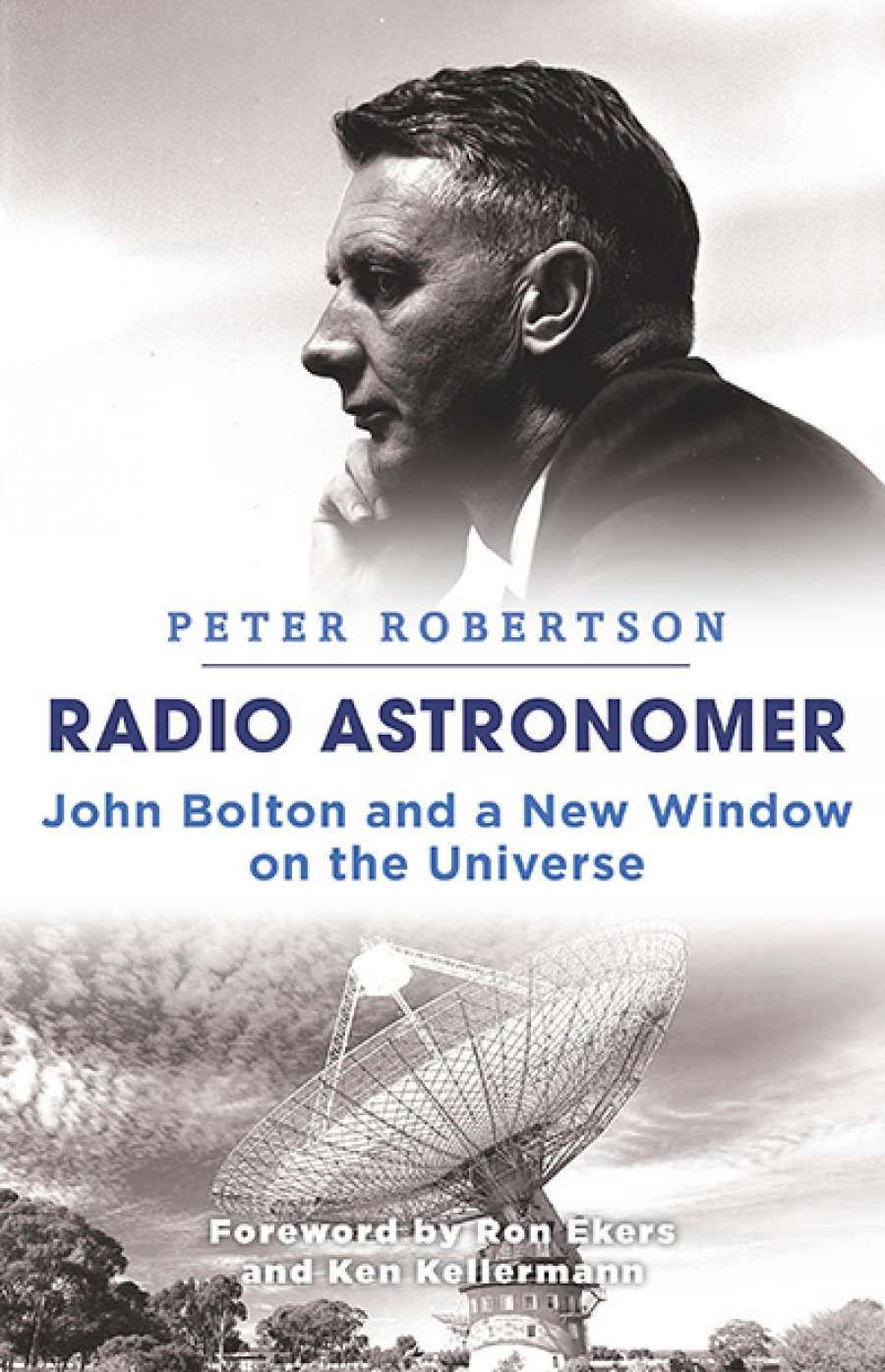
- Free Article: No
- Contents Category: Science and Technology
- Custom Article Title: Robyn Williams reviews 'Radio Astronomer: John Bolton and a new window on the universe' by Peter Robertson
- Book 1 Title: Radio Astronomer
- Book 1 Subtitle: John Bolton and a new window on the universe
- Book 1 Biblio: NewSouth, $59.99 hb, 432 pp, 9781742235455
Bolton grew up in England, gained scholarships to good schools and Trinity College, Cambridge, served in the navy (crucial in giving him hands-on experience as an engineer), and then found himself with that legendary band of ex-radar boffins who came to Australia from the forces after World War II. This was the A-plus team. They made this country the world leader in a scientific revolution, and their importance should not be forgotten.
Who outside the profession recalls their names today? I dread to think. There was Paul Wild, a great solar scientist who went on to head CSIRO; Harry Minnett, who adapted his cosmic skills to invent a landing system for aircraft (I am reminded of Dr John O’Sullivan from the same CSIRO department of Radiophysics, who adapted the technology he was using to find mini black holes to invent WiFi and change the world). There was the original boffin, dubbed so by Winston Churchill: Robert Hanbury Brown, professor of astronomy at the University of Sydney for twenty-seven years. I once introduced him to the staff at the History of Science Museum in Oxford in the 1990s. For them it was like meeting Elvis or Obama; they shook with delight. Yes, these were superstars just one generation ago. Taffy Bowen was the leader of the radar gang, most of whom knew their engineering and physics but damn all about astronomy; they had to bone up stargazing as they went along.
The only woman whose name appears in this list is the tragic Ruby Payne-Scott. She made crucial contributions to the radio revolution but was eventually discovered to have broken a sacred rule: she had got married, in secret. When this was discovered Payne-Scott had to resign from CSIRO. Recently, Brian Schmidt, Nobel Laureate and vice-chancellor of the Australian National University, told her story and burst into tears at the travesty.
Then there was the British contingent, still based there but with strong Australian connections: Bernard Lovell, of Jodrell Bank Observatory fame; and Fred Hoyle, another Yorkshire contrarian with his own maverick ideas on cosmology and the celestial origin of germs.
Author Peter Robertson tells how Bolton set up shop (more like a concrete shed) on Dover Heights, just up from Bondi Beach. It was there that they managed, for the first time, to pinpoint the radio signals from another star. The observatory was elaborated from an early warning system for spotting enemy aircraft during World War II and turned to the cosmos in the late 1940s and 1950s. Next, Bolton left Australia for Caltech and led their design of a radio dish to give Pasadena a nudge on the way to exploit the new ‘window’ on the universe.
 The Parkes radio telescope (photograph by John Sarkissian, CSIRO Parkes Observatory via Wikimedia Commons)
The Parkes radio telescope (photograph by John Sarkissian, CSIRO Parkes Observatory via Wikimedia Commons)
And so, to Parkes. One feature of this book is that there is a surprise on almost every page. It turns out that it was Barnes Wallis, father of those bouncing bombs and the Dam Busters, who designed the famous dish put up in the sheep paddock. It quickly, under Bolton’s leadership, cracked new records: finding quasars – quasi-stellar objects each emitting energy exceeding the lifetime heat of the sun – and more pulsars, once thought to be signals from Little Green Men, than all other telescopes put together.
Then came Apollo 11. It was the triumph of The Dish and the stuff of legend that Parkes turned from a back-up carrier of the signal from the moon in 1969 to the only class act. Armstrong and Aldrin were seen by the world that day by means of the telescope in the bush. And it has served with supreme magnificence ever since.
Bolton was a Pom who went native. I can think of few others who adapted so completely to life in an Australian country town while maintaining academic life at the highest level. Peter Robertson has brought us the incredible story of The Right Stuff Down Under.


Comments powered by CComment